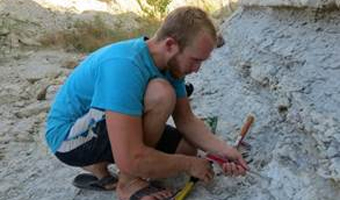Ohio University Geological Sciences graduate student Michael Blair presented “A Paleopedological and Ichnological Approach to Spatial and Temporal Variability in Pennsylvanian-Permian Strata in the Lower Dunkard Group, West Virginia” in October at the annual meeting of the Geological Society of American in Vancouver, British Columbia.
His co-author was Dr. Daniel Hembree, Associate Professor of Geological Sciences at Ohio University.
Abstract: Paleosols record a wealth of paleoenvironmental, paleoecologic, and paleoclimatic data. Plants and soil-dwelling animals both affect and are affected by soil properties. Their traces, therefore, serve to further refine the interpretations of paleosols, especially when ichnofossil assemblages correlate with specific paleosol properties. These characteristics make paleosols and ichnofossils invaluable in understanding lateral variability in the complex fluvial system represented by the upper fluvial plain facies province of the Upper Pennsylvanian to Lower Permian Dunkard Group. These deposits represent proximal to distal expressions of an anastomosing river and the associated floodplain. By understanding the degree to which paleosols change over short distances at a given time, interpretations of regional change through vertical successions can be better calibrated.
Field studies were conducted at a 45 m thick outcrop belt of the Lower Dunkard Group near Parkersburg, WV. The entire vertical section was measured and described with an emphasis on paleosols and associated ichnofossils. Several distinct pedotypes were encountered throughout this section ranging from deep-rooted, carbonate-rich, cumulative mudstone profiles to poorly developed, densely bioturbated proximal sandstones with horizontally branching roots.
With the exception of a coal, the paleosols exhibited evidence of a seasonal distribution of precipitation. A laterally continuous paleosol sequence was then described in eight different locations. Differences in the properties of this time-equivalent surface reflect spatial changes in environmental conditions. These differences were subtle when compared to the stratigraphically lower or higher paleosols, but were sufficient to infer variability in the paleolandscape. This was best reflected in rhizolith abundance, morphology, and taphonomy as well as the abundance and distribution of carbonate and iron mottles, nodules, and concretions.




















Comments